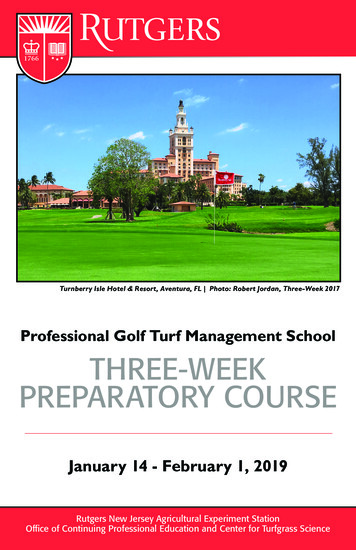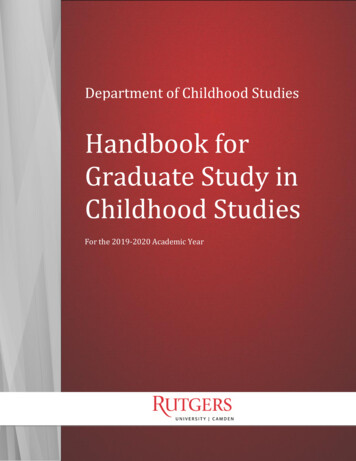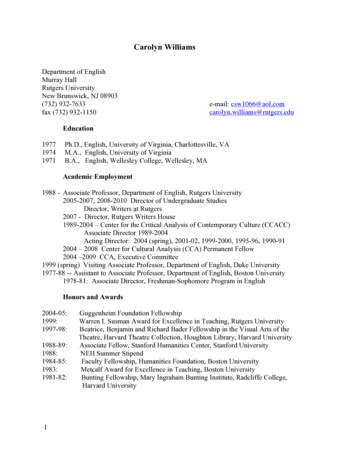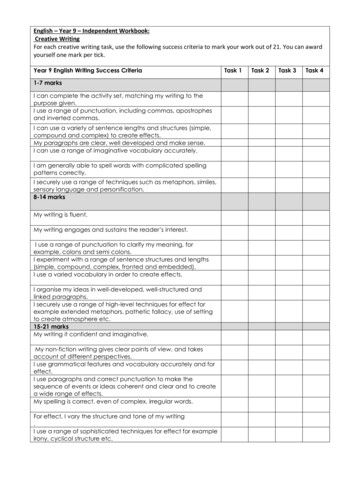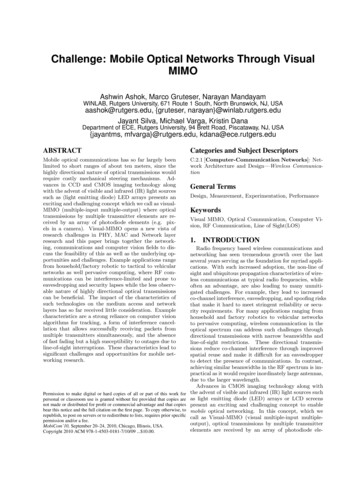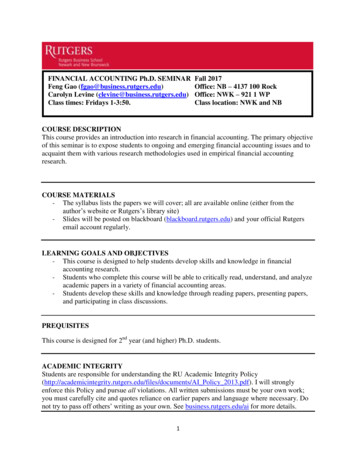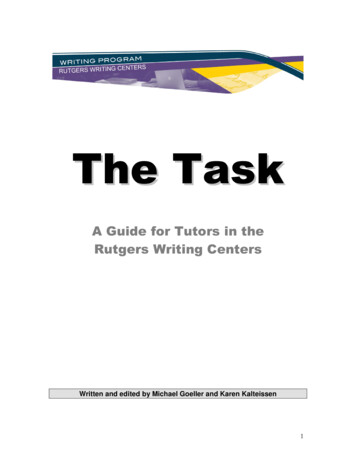
Transcription
Th e Ta s kA Guide for Tutors in theRutgers Writing CentersWritten and edited by Michael Goeller and Karen Kalteissen1
Copyright 2008 Rutgers University Writing ProgramWritten and edited by Michael Goeller and Karen Kalteissen, with assistance from Liz Varralhttp://wp.rutgers.edu/2008-2009 edition2
Table of ContentsTable of Contents .3PRINCIPLES .7The Task of Tutoring .7Authentic Tasks .7The Ten Commandments of Tutoring.7I. Be positive and do no harm.8II. Be friendly but don’t “socialize.” .8III. Cut the talking and get them writing.8IV. Think long term and don’t let “paper panic” shape the session. .9V. Keep the tasks authentic – there are no “generic” tasks.9VI. Don’t try to address everything – think “triage.” .9VII. Supplement and don’t supplant the teacher .10VIII. Be their coach, not their savior .10IX. Start with ideas, then work on form.10X. Teach the writer, not the writing.11Tutoring “Don’ts” .11A Writing Program Glossary .13Thesis? Argument? Project? Claim? .13Connective Thinking versus Mimetic Thinking .13Essays versus Stories .13Textual Responsibility .14Textual Protocols .14Conversation.14PRACTICES.17Start Up Tasks .17Assessing Strengths and Weaknesses with Self-Critique .17Loosening Up with “Free-writing” .17Making Lists .18Comparing Past and Present Papers.19Reading Tasks.19Getting to Know the Text.19Starting from Scratch—Still Not Having Read the Essay .19Breaking Down the Text .20Attributing Quotes .20Understanding Big Words.20Relating Passages .21Doing “Close Reading” .21Charting Main Ideas .21Finding the Author’s Main Idea .21Connection Tasks.22Clarifying Connections .22Free-writing with Structure .22Drawing Concept Maps.22Breaking Jargon Barriers.233
Constructing Connection Columns .23Quotation Tasks .24Quoting by Example.24Justifying Your Quotes .24Catching “Drop Quotes” .25Distinguishing between “Fact Quotes” and “Idea Quotes” .25Outline Tasks.25Essay Organizer .25Post-draft (or Reverse) Outline .26The Magic Paragraph Formula .26Reorganizing Ideas .27Topic Sentence Tasks.27Finding Lost Topic Sentences .27Topic Sentence Main Idea.28Sticking to Topic Sentences .28Dressing Up Your Topic Sentences .28Thesis Tasks.30“Solving the Thesis” to Find “Real” Answers .30Articulating Thesis Statements Before, During, After .30Finding a Thesis in the Conclusion .30Finding the Weaknesses in Your Thesis .31Developing a Thesis Pyramid .31The Anti-Thesis Route .31Tasks to Avoid Summary.32Using Open-Ended Questions .32Doing the Balancing Act .32Separating the Necessary from the Summary.32Paper Strengthening Tasks .33Anticipating Counter Arguments .33Using the Essay as a Model.33Discovering the Secondary Emerging Thesis.33Making Transitions.34Eliminating Repetition.34Thinking Back to Class Discussion.34Grammar Tasks .35Creating a Grammar Checklist .35Listening to Your Paper .35Going on a Grammar Hunt .36Simplifying the Grammar.36Tasks Using Teacher Materials.37Picking Supplemental Questions.37Deconstructing the Assignment Question.37Charting the Supplementary Questions .37Doing What Your Teacher Tells You .38Using Grading Rubrics and Sample Papers.38THEORY.40Minimalist Tutoring: Making Students Do All the Work By Jeff Brooks .40Assumptions.414
Basic Minimalist Tutoring.41Advanced Minimalist Tutoring .42Defensive Minimalist Tutoring .43Small Victories: The Practice and Process of Tutoring By Anthony Lioi .44Minimalist Tutoring.45The Structure of a Session.46The Post-Draft Outline .47Writing as Dialogue.48What Do We Mean By Peers? By Peter Carino .505
6
PRINCIPLESThe Task of Tutoring"Making the student do all the work" has become the mantra of what is called "minimalisttutoring," as first described by Jeff Brooks and as practiced at the Rutgers Writing Centers(and at practically every writing center across the country). The idea of the minimalist modelis that the writing tutor should not be a proofreader, fact-checker, editor, ghost writer,collaborator, or human thesaurus. In the minimalist model, the writing tutor is a mentor,coach, or task master who guides students through the process of revision and helps keepthem focused on the project at hand by breaking it down into smaller and more manageabletasks. In a sense, tutors help their clients to dismantle the wall of their "writer's block" – onebrick at a time.In the minimalist model, tutors don't do students' work for them, but they do a certain kindof work. The goal of this booklet is to describe the work that tutors do and to help tutorsstay focused on giving clients writing tasks that they can accomplish during the tutoringsession. It's our hope that, if nothing else, this booklet will expand the repertoire of tasksthat tutors have available to them for addressing the typical problems that studentsexperience at each stage of the writing process.Authentic TasksAs a new tutor, you have intuitive knowledge of how writing gets done and expertise inaccomplishing writing tasks. The goal of tutor training is to help you formulate yourintuition into principles and break down your expertise into specific practices. This bookletis not intended to be a "tutor by the numbers" guide. We do hope that the specific practicescontained in this booklet will help get any student started writing. Ultimately, though, youstill have be a "creative problem solver," able to apply the principles of minimalist tutoringmixed with the specific situation your client finds him or herself in, plus some of your ownknowledge of successful writing processes in order to invent new tasks or modify existingones to fit your client's specific needs. Our goal, after all, is always to teach people to fishand not to do the fishing for them.No book can tell you exactly what to do in any given situation. You have to respond to theneeds of your client. That begins with listening to the client and paying close attention to allthe details of what they say, then looking at any supporting materials they have brought(including the assignment question, the student's draft, or graded papers with the teacher'scomments). Use the clues of the situation to develop tasks that are most appropriate for theclient's needs. We call these “authentic tasks,” because they connect with students andaddress their real needs. What you will find in this booklet are suggestions for basic kinds oftasks you can tailor to fit the needs of each individual client during the time that you meet.The Ten Commandments of TutoringBefore we turn to the practices of tutoring, it's useful to review some of the guidingprinciples that should help shape our conversations with clients. We set these principles7
forth as "The Ten Commandments of Minimalist Tutoring," though we didn't exactly findthem on a mountain top and etched in stone. They are simply our best attempt to describe aset of rules that have worked well for us and which can help to guide your own work. And,unlike the Biblical edicts, we tried to come up with some "thou shalts" to accompany the"shalt nots."I. Be positive and do no harm.“Doing harm” in this context means doing anything that interferes with a client’s desire orability to write. Doing harm could be making fun of a student’s pronunciation or grammaror being overly critical of their behavior. Many students come to writing with a lot ofnegative baggage connected to their previous experiences of writing in school. Ask any ofthem to tell their "institutional writing autobiography," and you may hear stories of rulersmacks, mean comments, uninspired teaching, or what President Bush has called "the softbigotry of low expectations." I cannot tell you how many students have said to me over theyears that they "always got As" in high school writing but knew that the standards were toolow to inspire their best efforts. While some high school teachers of English create anegative atmosphere in the classroom, some others play the role of self-esteem boosters anddo not push their students to achieve anything close to their true potential. As a tutor, youget to be the best writing coach a student ever had by personalizing your lessons, keeping apositive attitude toward student success, and helping each student measure up to the highstandards that the Writing Program holds.II. Be friendly but don’t “socialize.”Tutors are expected to find a balance between “peer” and “authority,” as Peter Carino hassuggested. We are coaches, not teachers or friends. Establishing this relationship can feelstrange, especially if you are younger than your client. Just remember that your client soughtyour help because you have the more advanced skills in this particular field. The client’stransition to advanced skills is a process that will take place over time.III. Cut the talking and get them writing.The more a tutor talks, the less the client writes. A session in which a tutor and client“discuss” ideas may feel satisfying, but the discussion is often abstract and the client leavesthe Writing Center with little writing and quickly fading memories of the “discussion” inwhich the tutor did most of the talking. The student has made no progress with the paper.Instead, you want to move your clients quickly toward generating text and developing theirideas on paper. The most productive tutoring sessions are those that allow students to leavewith tangible results: notes and pre-writing that they have developed by working closely witha few key moments in the text, substantial revisions to one or more paragraphs in theirdrafts, or at the very least, written notes about the direction their next at home writingsession should take.On the other hand, a little conversation (as opposed to lecturing) is a good thing. First, youcan establish a relationship with the client through conversation, and the writing centershould be a place where a student can feel known. Talking can also be a time saver at thebeginning of the session in establishing a focus or finding out what the client may havelearned in class or in office hours since you last met. You can also ascertain what he or sheunderstands about the comments the teacher has written, or any lingering sources of anxiety.8
IV. Think long term and don’t let “paper panic” shape the session.While students want to focus on the last grade they got or the next grade they will get, wewant to urge them to focus on their overall progress and skills they are developing over thecourse of the semester. We show them how to receive teacher’s grades and commentscalmly as barometers of progress and as guidance for their next set of tasks. Do notdiscourage students from taking grades seriously, but lead them away from early despair. Tryto get them to concentrate on the comments more than the letter grades. However, if astudent seems to be making no progress over two or three papers, please speak with thecoordinator.If a student is frantic because he or she hasn’t started a paper that is due in two days (or twohours), you can gently suggest that students who come to tutoring with the most preliminarywork done make the most progress. Then go on to do what we always do—begin theassignment with appropriate tasks, reminding the student that he or she will continue thework you begin on her own and that you have several sessions to “nail” the writing process.Even if a student is in danger of failing the course late in the term, we should still focus onthe long term. After all, if the student cannot pass this term, he or she gets another semesterto reach greater potential as a writer.V. Keep the tasks authentic – there are no “generic” tasks.There should be nothing formulaic about tutoring. Each student brings different strengthsand weaknesses, each writing project has its own logic, and each step in the writing andrevision process has its own requirements. Tasks that address the unique writing situationand the unique writer will be “authentic.” A plan for one student’s paper may beinappropriate for another’s, or will surely be inappropriate for the same student’s next paper.Rather than assuming that the “Writing Process” is a sequential set of steps carved in stone,we help students identify the practices and writing strategies that are most productive forthem.You have three sources to consider when devising the right tasks for the right students inthe right sessions. First, you have the teacher’s comments on the last paper. Next, you havethe student’s assessment of his or her own writing. And finally, you have the student’swriting itself. No session should go by without you having read a student’s whole draft, orwhat there is of it. Practically speaking, you can’t always do this before assigning a start-uptask, but you need to make time as quickly as possible to read what the student has writtenwith respect and interest. Otherwise, you will be resorting to inauthentic or generic“tutoring tasks.”VI. Don’t try to address everything – think “triage.”The first time you see a student paper with lots of problems, you may think that you have totry to deal with everything that’s wrong or everything that might keep the student frompassing. You don’t. And don’t even try, or you’ll go crazy trying to cover it all and thestudent will not even be able to absorb it. Instead, think like an Emergency Room triagenurse and just identify the three areas that need the most help. Ask “where is the bleedingmost severe?” and “what problems are most likely to be fatal?” Recognize that the studentwill be back next week – and hopefully for five weeks – so you have plenty of opportunitiesto work on the less fatal issues during the rest of the term. The paper before you mightperish, but even a student who fails some papers can still be saved.9
VII. Supplement and don’t supplant the teacherYour work complements class work. It does not replicate or replace it. Teachers must focusprimarily on results and what is of “universal” concern to the group; tutors focus on processand what is of specific concern to the individual student. You have the luxury ofcustomizing assignments, strategies, and short-term goals. Teachers have syllabi to “keep upwith.” You can break down each discrete “writing moment” as much as your student needsyou to. Thus, you want to focus on very specific reading, writing, and critical thinkingstrategies rather than engaging in general conversations about the texts or the topic.Encourage students to take advantage of teacher office hours as a different sort of help fromtutoring – one that can help address the larger issues of the assignment. Ask students toreport back on what they learned in office hours.Most importantly, maintain your role as tutor and not teacher. Do not challenge theinstructor’s authority or question the instructor’s methods – at least not in front of yourclient, anyway. If you do see a problem with the teaching, bring it to the attention of theWriting Center director. Often what you see as a problem will really be a misunderstandingor miscommunication. But sometimes it will be a sign of a teacher who has gone astray andmay need some quick intervention to set back on track.VIII. Be their coach, not their saviorIf you’re half as invested in your students’ success as most tutors, you may be secretlydisheartened when your student does poorly on a paper. Keep it to yourself. Rememberthat what happens in tutoring is only a tiny portion of what goes into producing a paper.You may need to remind your client that you are not responsible for the paper’s success orfailure. The onus for success is on the writer, not the tutor. Don’t let your students getdependent on you. To avoid dependency, do not give students your email address or phonenumber, and do not meet them outside your scheduled session. You may seem like theworld’s “nicest tutor,” but you will just be encouraging tutor-dependence and helping yourstudents to continue to feel disempowered when it comes to writing.IX. Start with ideas, then work on formToo many tutoring sessions get derailed before they start with a focus on “the thesisstatement,” as though every paper needed one to get started. A “thesis statement” is rarely astarting place for writing. “The thesis statement” is simply the formal presentation of thewriter’s ideas – and those ideas can only emerge through the writing process. Much workcan and should come before it. It’s also common to look at a paper for the first time andimmediately be struck by the need to get it organized or cleaned up. In fact, many problemsin form are a manifestation of conceptual confusion, misunderstanding the assignment,misreading the texts, relying on underdeveloped ideas, making flimsy connections, etc.There is no point “fixing” a seriously flawed paper when clarifying connections and thoughtswill often help a student regain control of grammar and syntax. Address concepts and ideasfirst.A challenge may arise when a teacher sends a student to the Writing Center because thestudent keeps losing structural and formal control. Of course, we want to help studentswrite organized and correct papers, but those issues should not become our primaryconcern. Work you do with students on these issues should be:10
tied to the content of their papers (“Let’s work on these pronouns so your readerwill be clear about which of Gertner’s researchers made which discoveries”). geared toward strategies they can repeat on their own. discussed in clear ordinary English. (Who needs to know what to call ablativeabsolutes?) come after seriously revising ideas.With students who have serious presentation issues, you should spend at least some time ineach session addressing those issues directly. But generally that work should only come nearthe end of the session, after the larger conceptual tasks are completed.X. Teach the writer, not the writing.Don’t try to create the perfect paper. Try to create a better writer. In many ways, thiscommandment sums up all the others.The nine principles above provide the pedagogical basis for all that we do in the WritingCenter. Likewise, those same principles dictate what tutors do not do in the writing center –despite the temptations.Tutoring “Don’ts”1. Don’t proofread or edit, no matter how much the student begs.2. Don’t interpret texts for their students or suggest connections.3. Don’t provide a thesis, rearrange paragraphs, or otherwise do the work ofinterpretation or revision for a student.4. Don’t master a few “generic exercises” that they use in the same way for manystudents.5. Don’t assign “inauthentic tasks” – tasks that won’t help a student write a betterpaper – nor do they assign tasks the tutee could easily do at home: look up fifteenvocabulary words (one might be relevant to the task at hand), answer the questionsat the end of the selection; answer all the teacher’s “corollary questions” followingthe assignment question. (Conversation might, however, point to one or two thatdeserve your time.)6. Don’t speculate about the grade a paper will receive or should have received. Whenyou want to praise a student, focus on how hard the student has worked on thespecific task the session focused on.7. Don’t join students in “teacher bashing,” no matter what we think of the question,the comments, or the grade. If you have real concerns, try to get a chance tophotocopy the paper during the session and bring it to the coordinator.8. Don’t leave them alone for too long. This means that whenever you assign a tutee todo something, you will always come back and revisit what she has done, mining it for11
writing wisdom and material. This means you will have to budget your time,especially at the end of the session, so you can “decompress” with each of yourstudents. Freewriting, for example, needs to be revisited with a highlighter, to selectideas that the student can develop into paragraphs. Ask questions about what thestudent has accomplished, what kinds of obstacles she encountered, and ho
tutoring," as first described by Jeff Brooks and as practiced at the Rutgers Writing Centers (and at practically every writing center across the country). The idea of the minimalist model is that the writing tutor should not be a proofreader, fact-checker, editor, ghost writer, collaborator, or human thesaurus.


